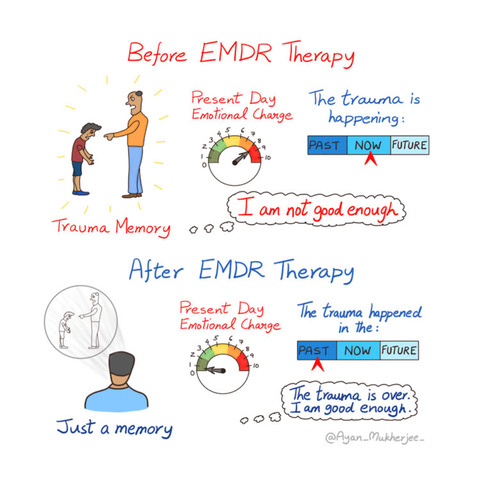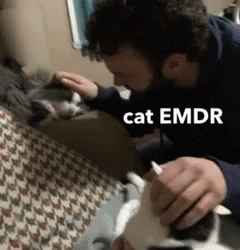EMDR is an incredible evidence-based therapy modality that helps people do more than just cope with negative experiences. EMDR helps you to transform the negative experiences in your life.
I offer EMDR in my therapy practice, and I’ve seen my clients benefit from profound healing and growth from using this therapy to work through their past. I have also done EMDR therapy as a client, and seeing how much I changed as a person and how so many areas of my own life improved is another reason why I love this therapy.
EMDR can definitely sound a little weird if someone has ever tried to describe it to you. Maybe you’re wondering if it’s something that might be helpful for you. You might already know you’re interested in EMDR but still want to know more about it. Or maybe you’re a neuroscience nerd like me and want to really understand how and why EMDR works.
In this post, I will explain EMDR therapy and hopefully answer those questions for you. And if this is way more than you wanted to know, just scroll to the bottom for my TL:DR summary.
What Does EMDR Therapy Stand For?
EMDR stands for Eye Movement Desensitization and Reprocessing. Say that five times fast! Just kidding. You never need to remember that, but you can if it makes you feel smart!
Francine Shapiro, the creator of EMDR, said that if she could go back, she would just call it “Reprocessing Therapy.” I think that name captures the essence of what this therapy does, which I hope will make sense to you by the end of this post!
What is EMDR Therapy Used to Treat?
One of the best things about EMDR is its versatility. This therapy has decades of research supporting it as being extremely effective in treating trauma. So I highly recommend considering EMDR if your struggles are linked to a specific traumatic memory or event. Examples would be a sexual assault, car accident, bad break-up, miscarriage, or traumatic birth.
EMDR also works well if your trauma was more of a series of events. Examples might be being bullied all through middle school, a toxic or abusive relationship, infertility treatment, divorce proceedings, or having your baby spend time in the NICU.
But what if I’ve never experienced trauma?
Maybe “trauma” feels like too strong of a word, but have you experienced anything in your life that you feel has had a lasting, negative impact on your life now?
Maybe you moved so much as a kid that you learned not to get too close to people so you wouldn’t get hurt. Now that you’re an adult, you still struggle to develop deep and meaningful friendships. Maybe your parents had high expectations for you and/or were very critical, and you were always trying to earn their approval and love by doing better at school or in sports. Now you’re a successful adult but deep down you still feel like you aren’t good enough.
EMDR and “Developmental Trauma”
Our core “emotional learnings,” aka our understandings of ourselves, others, and the world in general, develop very early. Our foundational core beliefs typically are developed before the age of 3, which is before we have any concrete memories!
So many adults are surprised to discover they have such deeply rooted negative core beliefs about themselves or others when they had a “pretty good childhood” or don’t feel as though they’ve experienced anything that would qualify as truly “traumatic.” But at those very early stages of development, feelings of shame or beliefs about being unlovable or unworthy can still get stuck from experiences that don’t really seem like a big deal. That is because things that seem trivial to us as an adult could have been incredibly impactful as an infant or toddler. This is called developmental trauma.
EMDR would define “trauma” as anything that happened to you or that you experienced that is continuing to have a negative impact on your life. So at the end of the day it doesn’t matter if “trauma” is the word you would use to describe your experiences. EMDR could be helpful for anyone who feels like things from their past are holding them back or keeping them from being the person they want to be or having the life they really want.
How EMDR Works in the Brain
A key premise of EMDR is the fact that we all have a “processing system” in our brain that helps us resolve disturbing life experiences. This is similar to how our body has a process for healing when we get a cut. Traumas sometimes cause this processing system to get stuck. When that happens, the experience gets stored in the brain as though it’s happening right now.
This is problematic when something happens in the present to trigger those memories. You suddenly experience the same feelings and bodily sensations you had when the trauma occurred. So maybe your heart starts racing and your palms get sweaty and you feel a surge of panic. This can feel especially unsettling if you aren’t aware that an old trauma is being triggered. It feels like your reaction came out of nowhere or that it doesn’t make any sense.
In addition to the feelings and sensations associated with traumatic events, “emotional learnings” can also get stuck. Emotional learnings are sometimes also called “core beliefs.” They define the way we view ourselves, others, and the world in general.
You can see in the illustration below how a traumatic memory from the past feels like it’s happening right now. You experience an intense “emotional charge” (feelings and body sensations) as well as a negative belief of “I am not good enough.”

The above visual aid is one of many used to help explain different concepts related to trauma and EMDR therapy that was created by the amazing psychotherapist and mental health illustrator, Ayan Mukherjee. You can check out all his work on his Instagram.
Often, when something traumatic happens, it seems to get locked in the nervous system with the original picture, sounds, thoughts and feelings. Since the experience is locked there, it continues to be triggered whenever a reminder comes up. It can be the basis for a lot of discomfort and negative emotions that we can’t seem to control. These are really the emotions connected with the old experience that are being triggered in the present moment.
What exactly does it mean for disturbing images, thoughts, and feelings to be “locked” in the nervous system? It means they are stored in the brain in a isolated memory network. In another part of the brain, in a separate network, is most of the information needed to resolve it. So all the other information you either already have in your brain or might be learning about in therapy that could help resolve the traumatic experience can’t link up.
This is one reason why some methods of therapy like CBT don’t work when there is trauma involved. When you’re learning to challenge negative thoughts and replace them with more positive ones, you’re creating new, very valuable pathways in your brain. But if it can’t link up with the trauma, it’s not going to make you feel better.
Bilateral Stimulation
EMDR uses something called bilateral stimulation to help information in your brain link up. Using some sort of side to side movement, it helps to activate both sides of your brain. It also activates something similar to REM sleep, which is when our brain normally processes and sorts through all our experiences from the day.
This side to side movement could include:
- eye movements where you track a light moving side to side on a “light bar” or a little ball moving from side to side on your computer screen
- using headphones listening to sounds that alternate sides
- holding little buzzers in each hand that buzz one at a time back and forth

So bilateral stimulation helps to “unlock” the nervous system and link up those memory networks. Linking up this information is a necessary step in allowing your brain to fully RE-process whatever got stuck.
Once you have re-processed an experience, your brain is then able to re-store the memory in a new way. Your brain sorts out what is useful from the experience and stores that information properly, and then lets go of whatever is not actually helpful for you to remember.
So any images, sounds, smells, emotions, and body sensations that are useful get stored correctly as being in the past. EMDR calls this desensitization, because it takes the “emotional charge” out of the memory and it no longer feels distressing to remember it. When all of this is done, you are able to remember and know that an event or experience was hurtful or upsetting when it happened, but you longer feel how hurtful or upsetting it was now.
Your brain is also able to “overwrite” the negative belief that was tied to the memory and attach a new, positive perspective. As your core beliefs change, so does the primary “lens” through which you see the world. And so once this new belief links up with all your different memory networks, it completely transforms how you view yourself and others. This is what makes it possible to experience lasting change after EMDR processing.
Is EMDR Right for Me?
Now that you’ve heard me explain EMDR therapy and how it works, you may be wondering if it would be a good fit for you. This will depend on what you’re wanting to work on, as well as how much time and money you are able to invest in your healing during this season of you life.
Who Is EMDR Appropriate For?
As I already discussed, EMDR is a good approach for anyone wanting to work through experiences from their past that are continuing to have a negative impact on their life today.
The hallmark of EMDR treatment is an accelerated reprocessing of distressing past experiences, which can be emotionally intense. Re-processing is challenging, sometimes exhausting work. Revisiting your worst memories and most painful emotions can feel very unpleasant.
Note: it is true that doing EMDR can absolutely make you feel worse sometimes because it is bringing up old, unresolved painful things. But EMDR will not actually make you worse.
And so with the right preparation before beginning the reprocessing, EMDR can be unpleasant but it is not not re-traumatizing. It is a difficult, but tolerable experience that can bring powerful relief.
However, for various reasons, someone might not be in a place where really digging into their past or deeper issues is something that they have the mental or emotional energy to do right now. That is totally okay! But it does mean that EMDR may not be appropriate during this season of their life.
Can EMDR Be Done Virtually?
Yes! The bilateral stimulation is only thing about EMDR that has to be “translated” for online sessions. One silver lining of the pandemic is that there are now so many quality platforms offering a variety of options for the bilateral stimulation. For example, I use a platform called remotEMDR. Clients are able to access it on whichever device they use for their video sessions.
So EMDR can be used whether you are seeking in-person sessions or you prefer to do therapy online.
Is EMDR Covered By Insurance?
Yes! If your therapist accepts insurance, then it doesn’t matter which type of therapy they are using. They will still bill your insurance for a psychotherapy session.
However, many EMDR therapists do not accept insurance because of the time limitation that insurance companies put on sessions. In a standard 50-minute session, a little bit of time is spent checking in and wrapping up in every session. It also often takes people a little while to “get in the zone” of processing. This means that you might only spend 40 minutes processing and only 20 minutes where it feels like your brain is really making some progress.
Therefore, many EMDR therapists prefer to offer longer sessions or even “intensives” to maximize the time you can spend actually processing. This clients to see progress much more quickly! Unfortunately, these sessions are not covered by insurance.
How Many Sessions of EMDR are Needed?
The good news is that because EMDR allows you to do accelerated reprocessing, it also brings about and “accelerated resolution” in comparison to many other kinds of therapies! For example, someone experiencing PTSD from a single-incident trauma, such as a car accident, might need as few as 3 sessions to bring about complete relief!
The bad news is that EMDR is not magic. If you have experienced multiple traumas in your adulthood that you want to work through, and/or if you experienced complex/developmental trauma from growing up with abusive, neglectful, absent, or otherwise unsupportive parents, then there is obviously much more for you to reprocess. However, you can still experience significant relief from successfully reprocessing just one of your traumas.
TL:DR

You can think of EMDR as “Reprocessing Therapy.” We all have a “processing system” in our brain that helps us resolve disturbing life experiences. This is similar to how our body has a process for healing when we get a cut. Sometimes this process gets stuck! This can be due to clearly traumatic events or due to experiences that don’t seem like that big of a deal.
EMDR uses bilateral stimulation (side to side movement) to help get things unstuck. The different parts of our brain are able to link up and we can actually finish processing whatever we went through. We keep what is useful to remember, and we let go of the rest. The memory is able to exist fully in the past, without any “emotional charge” getting triggered in our present. We develop a new understanding of what we went through and have a positive core belief attached to the experience instead of a negative one.
EMDR therapy is hard work, but if you’re ready, re-processing can bring about real healing. Disturbing experiences from your past can be transformed into a source of strength and self-love, bringing power to your present and a renewed hope for your future.
You deserve to experience the freedom and ability to live the life you truly want…
EMDR Therapy can help!
Are you looking for an EMDR therapist in Denver (or online for anyone living in Colorado or Georgia)? You can learn more about my therapy practice here.
Leave a Reply
Contact
THANK YOU!
We received your information and we will be in touch soon. Please allow 48 hours response time.
